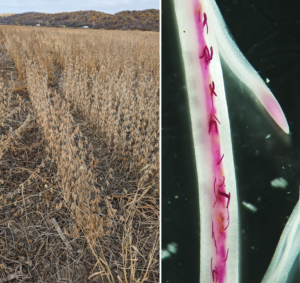(Jefferson City, Mo.) — Researchers in the University of Missouri’s Division of Plant Science and Technology have been academic and industry leaders in deciphering the underlying genetic mechanisms soybeans utilize to defend against soybean cyst nematode (SCN). For the last four years, a team of scientists at the University of Missouri, the University of Georgia (UGA), and the United States Department of Agriculture (USDA) have been devoted to discovering a new gene to combat SCN and improve the profitability and productivity of farmers worldwide. As a result, the research has led to the recent discovery of a new gene, GmSNAP02, for soybean breeders, farmers, and private industry to utilize. The study was published last week in Nature Communications.
(UGA), and the United States Department of Agriculture (USDA) have been devoted to discovering a new gene to combat SCN and improve the profitability and productivity of farmers worldwide. As a result, the research has led to the recent discovery of a new gene, GmSNAP02, for soybean breeders, farmers, and private industry to utilize. The study was published last week in Nature Communications.
“This is a novel mechanism for SCN resistance and serves as an instrumental breakthrough for farmers in Missouri and beyond,” said Missouri Soybean Merchandising Council chairman Aaron Porter. “The next step will be to rapidly integrate this gene into soybean varieties planted by farmers across the country.”
Plant-parasitic nematodes significantly threaten global agriculture. Realized annual losses by U.S. producers from SCN damage are billions of dollars. Recently, these losses have been exacerbated by a shift in the virulence of this pathogen due to the overuse of known resistance genes and the limited options available to farmers to control these losses with improved cultivars or new management strategies beyond only early season protection with seed treatments. With increasing nematode resistance to the commonly used SCN resistance source PI 88788, the discovery of GmSNAP02 offers new hope for combating this destructive pest and improving soybean productivity.
“Results of the last statewide survey of SCN in Missouri made us aware of the increasing problem of virulent HG type 1.2. SCN populations, a trend that is also observed throughout the Midwest, and this resistance gene offers a new tool for management that will target those problem SCN populations,” said Clinton Meinhardt, a researcher and lab manager for the northern soybean breeding program at the University of Missouri-Columbia.
The interdisciplinary research team was led by Dr. Andrew Scaboo at the University of Missouri and Dr. Melissa Mitchum at UGA. Using unique bi-parental populations, the research team employed advanced techniques to map, fine-map, and select GmSNAP02 as a candidate gene. To further validate their findings, the team utilized CRISPR-Cas9 genome editing technology and observed a gain of resistance in edited plants. The team also unraveled the answers to the effectiveness of different gene combinations while stacked with the GmSNAP02 gene and developed molecular assays for gene detection.
“This discovery represents a breakthrough that has an immediate impact on soybean growers,” said Dr. Mariola Usovsky, a research scientist at the University of Missouri-Columbia. “With the employment of GmSNAP02 and other known underutilized genes, farmers will soon have a choice to buy seeds with resistance that will precisely target nematodes in their field.”
These groundbreaking discoveries open new possibilities for developing soybean varieties with enhanced resistance to SCN. Dr. Scaboo’s soybean breeding program works on the next steps to rapidly integrate this gene into new soybean varieties.
“Here we used CRISPR-Cas9 technology as a more precise way to confirm GmSNAP02 function in soybean resistance to SCN,” said Vinavi Gamage, a Ph.D. candidate at UGA’s Institute of Plant Breeding, Genetics, and Genomics (IPBGG) and co-first author of the study. “What’s exciting is that our discovery has not only identified a new resistance gene but a gene editing-amenable resistance gene, opening the door for CRISPR-Cas9 technology that may make it easier and potentially faster for breeders to develop soybean cultivars with enhanced resistance to SCN.”
“Moreover, the nature of this resistance gene has provided us with new insights about how SCN may be adapting to overcome genetic resistance mechanisms in the soybean plant,” said Dr. Melissa Mitchum, professor in the Department of Plant Pathology and IPBGG at the UGA College of Agricultural and Environmental Sciences. “A better understanding of how SCN circumvents the soybean plant’s resistance response is necessary for enhancing the durability of resistance genes by providing soybean farmers with more prescriptive management approaches.”
By harnessing the power of GmSNAP02, farmers can look forward to increased yields and reduced economic losses caused by SCN.
“The results found in this research will have a significant impact on the varieties grown by farmers now and in the future to combat SCN,” said Dr. Andrew Scaboo, assistant professor at the University of Missouri–Columbia. “Although SCN will continue to evolve, we now have a new genetic technology desperately needed to improve productivity in soybean farmers’ fields in Missouri.”
For more information about this research, please contact Missouri Soybeans’ director of agronomy and research, Eric Oseland, at eoseland@mosoy.org or visit mosoy.org.